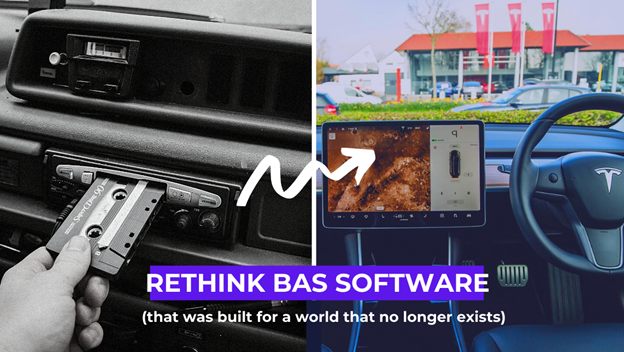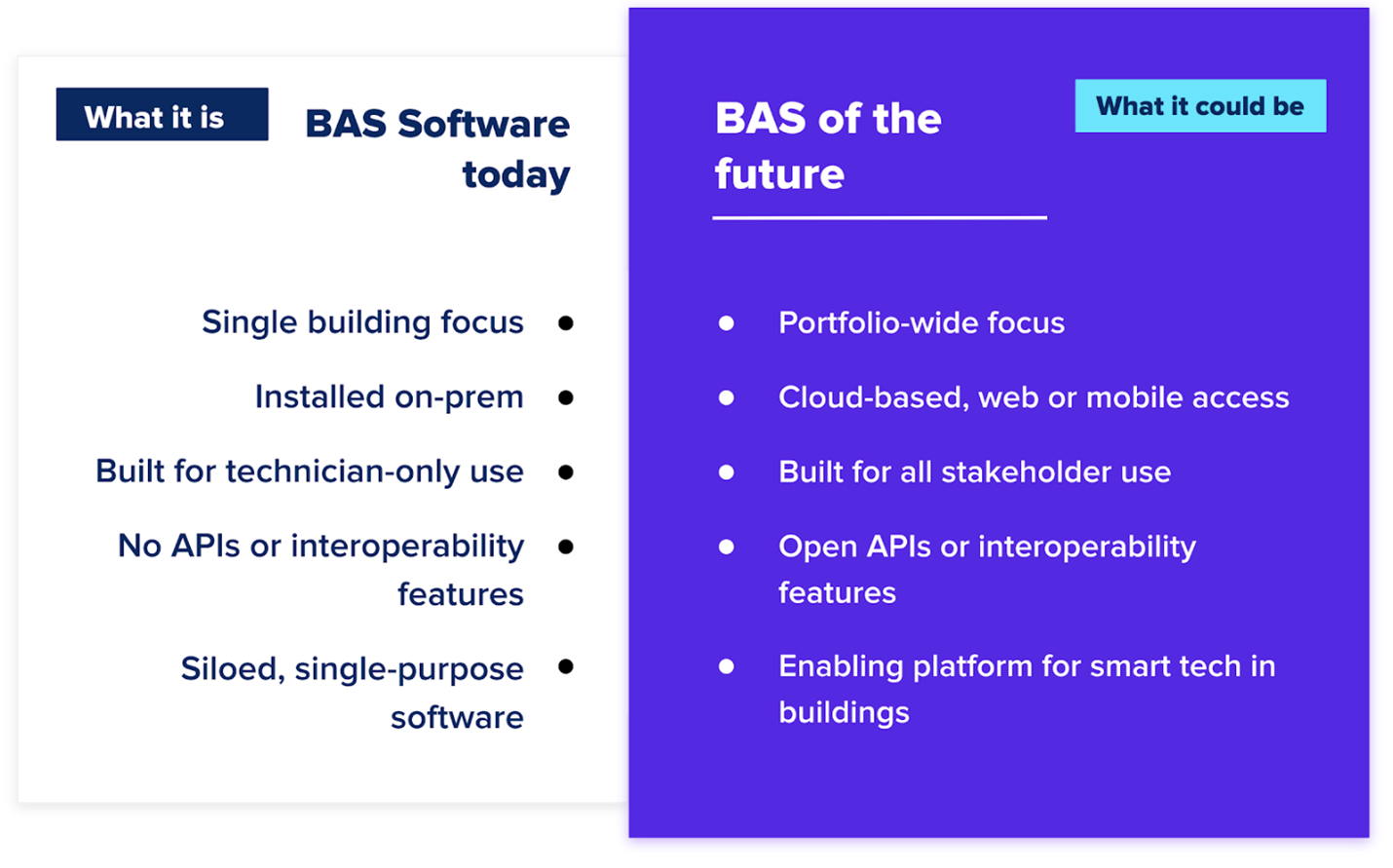 2020 may go down as the year when longstanding issues in the BAS industry ignited a whole new level of interest. Those shortfalls can include software that is out-of-date, a certain lack of openness, and a business model with roots in prior decades. Recently, the constraints imposed by the pandemic in building operations have really put BAS in the spotlight. It’s never been more crucial to be able to access real-time building information for building operation decisions. And the realization—that the software may not be providing access and data-sharing in real-time in the best ways, lacks interoperability with other systems, and is questionably “old school”—has finally hit us hard.
2020 may go down as the year when longstanding issues in the BAS industry ignited a whole new level of interest. Those shortfalls can include software that is out-of-date, a certain lack of openness, and a business model with roots in prior decades. Recently, the constraints imposed by the pandemic in building operations have really put BAS in the spotlight. It’s never been more crucial to be able to access real-time building information for building operation decisions. And the realization—that the software may not be providing access and data-sharing in real-time in the best ways, lacks interoperability with other systems, and is questionably “old school”—has finally hit us hard.
The current BAS business model has deterred innovation
In an alternate world, BAS could be the core driver of real estate operations and portfolio-wide performance. BAS could be a data powerhouse that helps derive key operational insights in real-time. It could allow key stakeholders to peer into their operations, allowing better-informed strategic decisions. A new set of tactical measures could pave the way for new use-case deployments or performance optimizations within weeks (versus months today).
Most importantly, BAS might have embraced technological advancements brought by cloud-based services, the Internet of Things (IoT) and Big Data analytics to become a truly transformative force—providing solutions to all of the above and more. Instead, the service-heavy business model of BAS has placed significant disincentives on upgrades, and as a result, there are innovations that BAS has never experienced. BAS is usually limited in scope to equipment controls and alarm management, making it much harder for these systems to be used more broadly, beyond building-controls technicians.
In the meantime, there has been a growing need for software or systems that can work with BAS for data access or control based automation, in a more or less seamless way. Anyone who has attempted to do any efficiency-based initiative—e.g., real-time energy management, analytics, automated billing, a new sensor deployment in a building—can appreciate the value this could bring. The options available often come down to: (1) a painful building-wide system integration; or (2) a stitching together of complex manual workflows that end up adding to the existing building management silos. It may appear feasible to do this in one building, relying on a BAS vendor or contractor. But scaling this across a buildings portfolio is a daunting prospect.
This has important implications today. In a post-pandemic world—with entirely new occupant health and safety use cases that demand integration with smart sensors and equipment—status quo BAS software risks getting sidelined.
New synergies in property operations can be realized
 With advances in technology, it is not impossible or even too difficult to turn around the BAS data lock-in problem. Most BAS networks support IP-based open standard protocols like BACnet/IP, Modbus TCP/IP, OPC, etc. Using edge technology, accessing real-time building information from these networks becomes pretty straightforward. When cloud technology is combined with this, it becomes possible to see BAS’s unexplored potential.
With advances in technology, it is not impossible or even too difficult to turn around the BAS data lock-in problem. Most BAS networks support IP-based open standard protocols like BACnet/IP, Modbus TCP/IP, OPC, etc. Using edge technology, accessing real-time building information from these networks becomes pretty straightforward. When cloud technology is combined with this, it becomes possible to see BAS’s unexplored potential.
Take supervisory controls for building systems that are traditionally on-prem software, operating at a single-building level. With cloud-based platforms these functionalities could be made to run effortless across an entire portfolio, from one location. This approach lays the foundation for data-driven operations, and therein lies the key transformational change.
Imagine for a moment having historic BAS data collected over the years and across buildings on a cloud-based platform. What if that data could be normalized using a common data model- and naming standard? Analytics could be applied over unified data sets. Visibility into building operations could be shared—and insights derived—for key stakeholders. Consider, as well, that this same platform also enables data sharing with other applications that need this data. The ability to address all the key challenges of BAS system integration is now within reach. Moreover, a new kind of Computerized Maintenance Management System (CMMS) becomes possible. The data surfaced from the BAS enables maintenance to be performed based on the equipment condition, besides periodic maintenance. This also means that tenant servicing systems could automatically adjust HVAC schedules or override setpoints in a building based on occupant requests. The potential that this approach creates is powerful and lucrative in meeting the evolving operational demands of large organizations.
Turning to next-gen technologies for portfolio-wide automation
Over the past decade or so, building operators who have attempted to address the BAS problem have had to build solutions themselves with the help of IT-solution vendors, experienced MSIs, or automation vendors. Often these solutions were based on the same outdated BMS technologies, extending the same functionalities. But with multiple buildings, the effort required considerable time and expense to deploy. And even worse, sometimes these solutions didn’t even get deployed across portfolios, because of the same teething problems such as lack of openness and vendor lock-in.
BAS software has turned a corner with the commoditization of IoT, cloud, & analytics technologies. This is a game-changer with respect to the role of software in building automation & operations—a movement that is accelerated with growing cloud and IoT startups across the globe. The possibilities discussed earlier in this article are exciting, but they’re just the beginning. Once the data from building automation systems and sensors become readily available, an innovation barrier is lifted for real estate companies across asset classes to build solutions for countless needs in various operations and maintenance (O&M) contexts.
It is with this grand vision that Facilio has been building a cloud based O&M data platform that allows real estate portfolio owners and operators to consolidate data across building systems and optimize operations in various contexts. Learn more here about how Facilio can help solve the problem of BAS and unlock efficiencies in building operations for your portfolio.
 Rajavel Subramanian is the co-founder and the Head of Product at Facilio. He heads Facilio’s product strategy and is committed to making it easier for property stakeholders to maintain and operate large real estate portfolios spread across geographies. Raj’s career spans over 17 years of product and revenue operations focusing on enterprise-scale telecom, and IoT solutions. He is passionate about leveraging cloud-based solutions to solve operational challenges at portfolio scale and transforming the future of building automation.
Rajavel Subramanian is the co-founder and the Head of Product at Facilio. He heads Facilio’s product strategy and is committed to making it easier for property stakeholders to maintain and operate large real estate portfolios spread across geographies. Raj’s career spans over 17 years of product and revenue operations focusing on enterprise-scale telecom, and IoT solutions. He is passionate about leveraging cloud-based solutions to solve operational challenges at portfolio scale and transforming the future of building automation.

